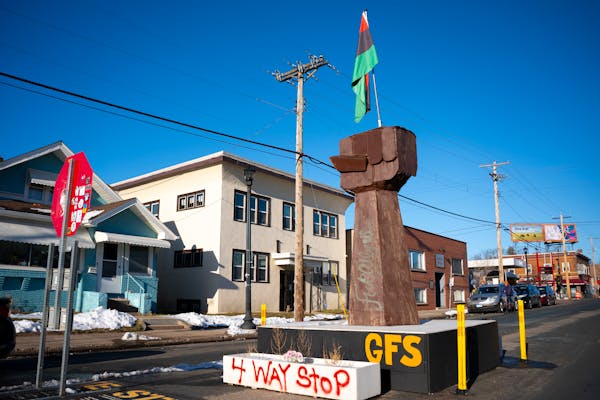Six years ago this summer, back in the innocent, pre-Trumpian epoch — when we thought American public life was plagued by "political polarization" but hadn't seen anything yet — I fretted in this space about a trend I'd been noticing on the Minnesota Supreme Court. I thought I detected a slight hardening of ideological lines and groupings on the court.
"Could this state's high court become like the famously fractious U.S. Supreme Court?" I wondered. "Could it split into ideological blocs, largely defined by the governor who appointed the justices, and with each bloc championing a starkly different philosophy about the proper role of courts in our democracy?"
We're overdue for an update.
The state high court began to change back in 2014 with the arrival of the first two justices appointed by Gov. Mark Dayton — at the time Minnesota's first DFL governor in 20 years. The court Dayton had inherited in 2011 was something of a motley crew, in terms of the justices' political backgrounds.
A bare, four-justice majority had been appointed by conservative Republican Gov. Tim Pawlenty. The other three justices consisted of two veterans of 1990s vintage — one appointed by moderate Republican Arne Carlson and one (Alan Page) directly elected to the court — plus another justice appointed by maverick Gov. Jesse Ventura.
This mixed assortment often proved an unpredictable tribunal without consistent lines of division. It had, among other things, overseen prolonged litigation over the U.S. Senate recount in 2008-09 that ultimately put Democrat Al Franken in office, and had ruled against Pawlenty in a pitched partisan budget fight involving an obscure unilateral maneuver called "unallotment."
But governors can sometimes put their stamp on the state Supreme Court quickly, given a mandatory retirement age of 70 for state judges and the frequency with which justices leave to return to private practice or join the federal bench. Dayton appointees have formed a majority on the court now for four years, and for two years five Dayton picks have sat on the seven-member court.
At the end of July, the first nominee of Gov. Tim Walz, Judge Gordon Moore of Worthington, will join the high court, replacing retiring Justice David Lillehaug.
So, have fears about the court dividing into rigid ideological blocs come to pass? Suffice it to say that a recent series of politically charged rulings have not exactly set all such concerns to rest. Consider:
• Earlier this month, the court settled a yearslong court battle between the city of Minneapolis and the Minnesota Chamber of Commerce over the city's Sick and Safe Time Ordinance. The court ruled that the city can properly impose its regulations even on employers outside the city who send workers into Minneapolis. The vote was 5-2, with all the Dayton appointees joining the decision. Dissenting were the two remaining Pawlenty appointees — Chief Justice Lorie Skjerven Gildea and Justice G. Barry Anderson.
• In May, in another closely watched case, the court overruled the Court of Appeals and held that the state Department of Natural Resources had the authority to change the name of what used to be Lake Calhoun to Bde Maka Ska. Five Dayton appointees agreed. Gildea and Anderson filed a strongly worded dissent.
• In April, again overruling lower courts, five Dayton justices ruled that DFL Secretary of State Steve Simon was within his rights in denying voter registration data to a political advocacy group bent on investigating what it believes is widespread voter fraud, a concern Simon and most DFLers dismiss. Gildea and Anderson dissented.
• In February, Gildea and Anderson dissented from a 5-2 ruling that granted news media expansive potential protection from defamation lawsuits, even after disseminating police statements about a murder suspect that proved to be unfounded.
• In October 2019, a 5-2 majority (Gildea and Anderson dissenting) barred the city of Brainerd from dismantling its full-time fire department in a cost-cutting move and replacing it with a part-time firefighter team, because doing so violated union protections.
• Reaching back to 2018, Gildea and Anderson were the only dissenters in what may prove the single most momentous recent decision of the state high court. In the Cruz-Guzman case, the court majority ruled that courts can decide whether the state is fulfilling its constitutional duty to provide an "adequate" education to all the state's children, and require it do so, potentially giving the judiciary expansive powers to make education policy.
There have been other cases fitting this pattern, but these stand out for the tolerably clear ideological battle lines and the progressive-pleasing outcomes. A pattern is detectable in the legal philosophies at work as well.
Repeatedly in these cases, the court majority has found new meanings in legal texts that give courts or executive branch agencies previously unsuspected powers, or expand protections to private institutions such as news media or unions. Gildea and Anderson repeatedly argue for more strictly following the existing text of laws and leaving it to the Legislature to make changes and new policy.
It's not my purpose here to take sides in that philosophical quarrel. It certainly remains true that the large majority of state high court decisions do not divide the justices in any politically suggestive fashion. Still, Minnesota voters have a right and an obligation to notice if their courts begin behaving more ideologically, with consistent and predictable alignments of judges appearing reliably on politically sensitive cases.
Minnesota prides itself on generally keeping politics out of its judicial selection processes, including its low-intensity elections for judges. But that can endure only so long as courts really do remain mostly apolitical. That's something for the judges to consider.
D.J. Tice is at Doug.Tice@startribune.com.
Morris: We remain confident in our decision to pause endorsements
Readers Write: Presidential, judicial, Second District and Senate races

